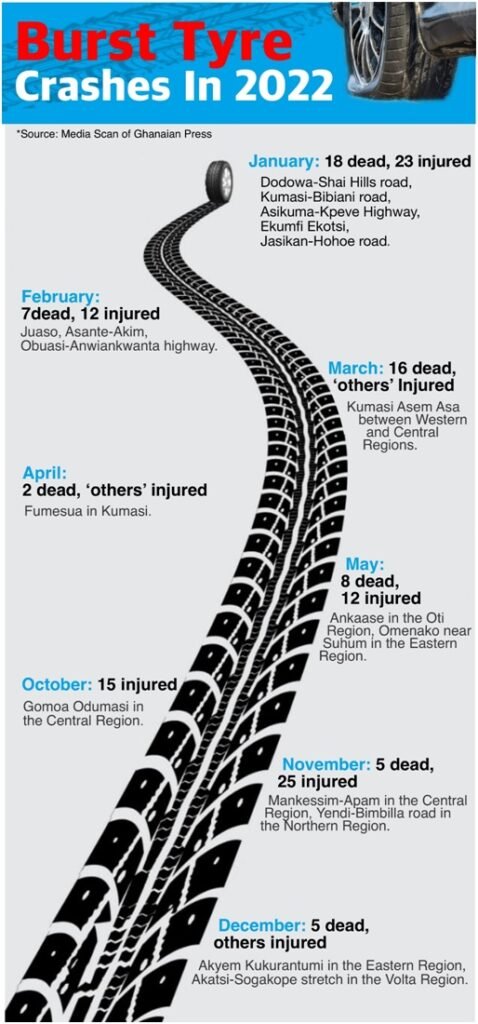
Round, rubber and rimmed; they revolve on roads relentlessly, regardless of rain or radiance, till rested by riders.
Tyres; they are tough: they take up tons of goods and travellers, through the thick and thin of time till they are tired.
Then, they turn into traffic traps, taking lives and leaving a trail of tragedy and trauma.
One such life was that of 37-year-old Samuel Nuamah, a celebrated journalist at the New Times Corporation.
On August 20, 2015, when the Ghanaian Times’ presidential correspondent and his colleagues set off to Accra from Ho in the Volta Region, where they had covered a presidential event, the expectation was that they would file stories that would feature prominently on news bulletins and in newspapers.
But, alas! Fate had drafted a different story that would change Nuamah’s byline into a headline.
At about 2:30 p.m, upon reaching the Doryumu Junction, near Shai Shills in the Greater Accra Region, the story unfolded.
“The bus burst its rear left tyre; the driver applied the brakes; lost control and the vehicle skidded off the road into a muddy ditch” reported the Ghanaian Times in it is August 21, 2015 edition under the banner headline “Nuamah is dead.”

The 11 other presidential correspondents aboard escaped death by a whisker but were not spared injuries.
One of them, Edward Kwabi, suffered a fracture in his leg that was later supported by a metal implant until his demise three years ago.
The rest of the victims carry scars on their bodies and horrid memories in their minds.
Investigations by the Ghana Police Service and the National Road Safety Authority (NRSA) revealed that the tyres of the bus had defects, hence the burst, but the investigation into the crash went cold with time.
Tyre deaths, injuries
Before and after this tragedy, many lives have been lost in crashes caused by burst tyres. A media scan shows that 61 deaths and more than 87 persons were injured last year through such crashes (see infographic for details).

They are among the 2,373 people who died and 15, 690 injured persons in 14,960 crashes involving 25,754 vehicles, according to data released by the NSRA.
Alarming as these deaths are, tyre regulation in the country seems not to be getting significant attention.
There is no laboratory in Ghana that checks the quality of tyres imported; there is no official data on tyre burst crashes.
Used tyres are not illegal despite a study by the NRSA that shows that they increase the risk of a crash, while the enforcement of regulations on tyres is a challenge as stakeholders work in silos.
Regulation
In Ghana, Regulation 62 of the Road Traffic Regulation 2012 (LI 2180) provides that the importer of a motor vehicle or trailer shall ensure that the motor vehicle or trailer “is fitted with pneumatic tyres manufactured for use in hot and normal areas labelled temperature Class A or B”. This means that those labelled C and meant for cold areas are prohibited.
In addition, importers are to ensure that tyres are of the specified size and can withstand the maximum permissible loads of the motor vehicle to which they are fitted, meaning a saloon car tyre should not be used by a pick-up vehicle.
The regulation also specifies that importers are to make sure that trailers and other vehicles are fitted with tyres whose pressure is specified by the vehicle manufacturer and that the maximum thread depth of all categories of tyres must be 1.6 millimetres.
It indicates that anyone who drives or is in charge of a motor vehicle should ensure that the vehicle is equipped with a spare tyre that meets the required standard and is inflated.
Study
Although the law does not ban used tyres, study conducted by the NRSA cast dark clouds over the use of second-hand tyres. It established that the patronage of used tyresincreased the risk of crash occurrence by 30 per cent.
It said 15.2 per cent of vehicles involved in fatal crashes had some form of defect prior to the crash, which was in the form of a tyre burst or blown-up tyre pressure situations that also constituted 4.4 per cent of these defects.

Tyre business
The preference for used tyres was confirmed at AbosseyOkai, Ghana’s biggest spare parts hub. The section that hosts tyres has more than 300 shops filled with tyres of different sizes and make, mainly second-hand tyres.
According to Mr Atta Nsafoa, the Secretary of the tyre dealers association, about 2.2 million pieces of second-hand tyres are sold at the hub every year.
“Many of the people come here to buy second-hand tyres because they cannot purchase brand new ones. They use them for about two years or less and they can come back and make new purchases,” he said.
Mr Nsafoa explained that for vehicles like Range Rover, prices of their brand new tyres ranged from GHc 1,500 to GHc2,000 and because the owners of such vehicles value them, they always buy brand newtyres.
He said GHc350 could buy brand new tyresfor smaller vehicles, while GHc150 was for a healthy second-hand one.
The taste for cheaper tyres was corroborated by many commercial drivers interviewed, including Kwame Afum who added that they purchased such tyres to sustain their business and not to endanger the lives of passengers.
Road Safety Authority
When contacted, the Head of the Monitoring and Evaluation Unit of the NSRA, Gabriel Adu-Sarpong, said the Authority was not against used tyres but rather substandard tyres defined by Regulation 62 of the Road Traffic Regulations 2012.
He explained that some tyres could be new but might have expired or exceeded the speed or weight limit.
“You can have a used tyre which meets all the specifications but new ones which are substandard. That notwithstanding, tyres should always be in good condition to prevent crashes,” he said.
Shedding light on the enforcement of these specifications, he said the current legislative instrument governing the work of the authority only mandated it to educate the public.
He said a new legislative instrument was awaiting passage to give the NSRA the mandate to check the operation permits and vehicle parts of transit operations.
Mr Adu-Sarpong said inspection of substandard tyres was the responsibility of the Motor Traffic and Transport Department (MTTD) of the Ghana Police Service.
Police
When the Police MTTD was contacted, the Head of Education Research and Training at the department, Chief Superintendent Alexander Kweku Obeng, said during road patrols, the police only conducted a physical inspections of tyres; whether they are in good condition, and if they bore the right labels.
He said the dates of manufacturing were not checked because there was no consensus on that issue and that the NRSA and stakeholders at the ports were holding consultations to find a middle ground.
He added that ideally there should be equipment at the ports to check if tyres meet the regulations before allowing them into the market, but that is not the case.
Chief Supt Obeng said enforcement of the regulations on tyres could be better if there are standards and expressed the hope that the new L. I would cover all the grey areas for effective implementation.
On the non-existence of data on tyre burst crashes, he said seeing a burst tyre at a crash scene did not meant it was the major cause because other factors could contribute to a crash, which require careful analysis.
Ports
The General Manager for Marketing and Corporate Affairs of the Ghana Ports and Harbours Authority (GPHA), Esther Gyebi-Donkor, when contacted about the import of tyres, said they only released them to importers after the Ghana Standards Authority (GSA) had given the green light that the tyres met the required standards.
Standards Authority
For his part, the Acting Head of the Import Inspection Department at GSA, Stephen Adu, confirmed that the country did not have a laboratory to check tyres that came into the country and advocated one either through government intervention or public-private partnership.
He explained that such a facility would help conduct better inspection and testing of the tyres to reveal the defects and other substances like the load capacity of the tyres which physical examination could miss.
In the meantime, he said, the Authority had partnered with globally-certified testing agencies abroad which check the tyres using Ghana’s standards and then issue a certificate of conformity to the importer and further checks done at the ports before the consignment is cleared.
Additionally, he said, samples of tyres are physically inspected if they met the requirements of the LI.
He added that the challenge was that due to the loads, not all items were checked.
“The disadvantage of the physical inspection is that some importers can emboss different expiry dates on the tyres,” he said, adding that the country’s porous borderspaved the way for substandard tyres to enter it.
Way forward
The UN’s Sustainable Development Goals target 3.6 enjoins countries to halve the number of global deaths and injuries from road traffic crashes.
By giving attention to the regulation and enforcement of defective tyres, Ghana would have a chance to meet this target and save lives.
Regulators need to enforce the law to the letter through collaborative efforts. The state should set up a tyre-testing laboratory to enable the GSA to do its work effectively and if the study by GSA is anything to go by then used tyres should be banned.
BY JONATHAN DONKOR




